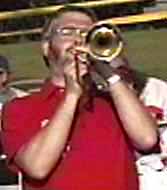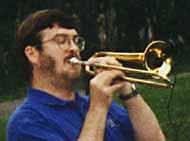Like other members of the slide trombone family, the soprano trombone has a
seven-position slide for changing the pitch. The soprano trombone is also called
a slide trumpet, although the latter term also applies to a historical instrument
with a three-position slide used primarily in England in the 19th century.
The DEG soprano trombone shown in the pictures above has a very narrow distance
from one slide tube to the next. Others are built with a slide width more like
that of a tenor trombone.
For anyone considering taking up the soprano trombone, Glen Newton offers these
comments:
The slide positions
are half as long as the positions on a tenor trombone. (Watch out that first
time you go for 7th position--- you might end up separating the inner and
outer slides!)
The relation
of the bell to 3rd and 4th positions might not be the same as what you're
used to on a tenor trombone. E.g., if you've become accustomed to finding
3rd position by holding up your index finger and touching the bell, you may
have to relearn how to find 3rd. BUT this depends on the make of soprano trombone
(similar to the problem of finding 3rd position relative to the bell on a
bass or alto trombone).
Also, any flaws
in the smoothness of the slide are more apparent with a soprano trombone,
because you don't have the mass of the bigger instrument to compensate for
the little jerkiness that a stubborn slide can bring. To help protect your
lips from bruising when you return the slide quickly to first position, tune
the instrument sharp, if you can, so that first position notes play in tune
when the slide is 1/4" to 1/8" out from the fully closed position.
In comparison
with the trumpet, the soprano trombone feels very free-blowing. (Having fewer
angles for the air stream accounts for part of this difference.) This is good
for tone production, but it also means that some lip slurs and shakes are
harder because you can't depend on the air stream resistance to help you with
them.
Usually the music
is written as though it was to be played by a trumpet player, so it's transposed
a step. Thus your tuning note would be written as a C in the middle of the
treble staff, rather than a Bb. For tenor trombone players who double on trumpet
this is an easy mental adjustment, but for others it is similar to learning
to read alto or tenor clef.
Also, sad to
say, most listeners would MUCH rather hear a tenor (regular) trombone or a
trumpet than a soprano trombone. It's closely related to why people would
rather hear a flute than a piccolo. The smaller instrument is harder to play
in tune and has such a unique tone that it's easy to get too much of it.
Furthermore,
there are no soprano trombone parts in the band or orchestra. Unless you have
a specific ensemble (like a trombone choir) or solo situation in mind that
calls for the soprano trombone, you might not have much opportunity to perform
in public.

